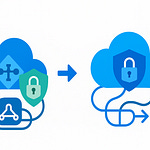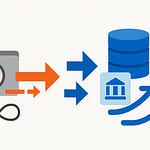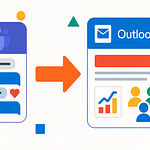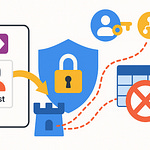Imagine deploying Copilot across your entire workforce—only to realize later that employees could use it to surface highly sensitive contracts in seconds. That’s not science fiction—it’s one of the most common Copilot risks organizations face right now. The shocking part? Most companies don’t even know it’s happening. Today, we’re unpacking how Microsoft Purview provides oversight, giving you the ability to embrace Copilot’s benefits without gambling with compliance and security.
The Hidden Risks of Copilot Today
Most IT leaders assume Copilot behaves like any other Microsoft 365 feature—just an extra button inside Word, Outlook, or Teams. It looks simple, almost like spellcheck or track changes. But the difference is that Copilot doesn’t stop at the edge of a single file. By design, it pulls from SharePoint libraries, OneDrive folders, and other data across your tenant. Instead of waiting for approvals or requiring a request ticket, Copilot aggregates everything a user technically has access to and makes it available in one place. That shift—from opening one file at a time to receiving blended context instantly—is where the hidden risk starts.
On one hand, this seamless access is why departments see immediate productivity gains. A quick prompt can produce a draft that pulls from months of emails, meeting notes, or archived project decks. On the other hand, there’s no built‑in guardrail that tells Copilot, “Don’t combine data from this restricted folder.” If content falls inside a user’s permissions, Copilot treats it as usable context. That’s very different from a human opening a document deliberately, because the AI can assemble insights across sources without the user even realizing where the details came from.
Take a simple example: a junior analyst in finance tasked with writing a short performance summary. In the past they might have pieced together last year’s presentation, checked a templates folder, and waited on approvals before referencing sensitive numbers. With Copilot, they can ask a single question and instantly receive a narrative that includes revenue forecasts meant only for senior leadership. The analyst never had to search for the file or even know it existed—yet the information still made its way into their draft. That speed feels powerful, but it creates exposure when outputs include insights never meant to be widely distributed.
This isn’t a rare edge case. Field experience has shown repeatedly that when Copilot is deployed without governance, organizations discover information flowing into drafts that compliance teams would consider highly sensitive. And it’s not only buried legacy files—it’s HR records, legal contracts, or in‑progress audits surfacing in ways nobody intended. For IT leaders, the challenge is that Copilot doesn’t break permission rules on paper. Instead, it operates within those permissions but changes the way the information is consumed, effectively flattening separation lines that used to exist.
The old permission model was easy to understand: you either opened the file or you didn’t. Logs captured who looked at what. But when Copilot summarizes multiple documents into one response, visibility breaks down. The user never “opened” ten files, yet the assistant may have drawn pieces from all of them. The traditional audit trail no longer describes what really happened. Industry research has also highlighted a related problem—many organizations already fail to fully track cloud file activity. Add AI responses on top of that, and you’re left with significant blind spots. It’s like running your security cameras but missing what happens when someone cuts across the corners outside their frame of view.
That’s what makes these risks so hard to manage. With Copilot in the mix, you can have employees unintentionally exposing sensitive information, compliance officers with no clear record of what was accessed, and IT staff unable to reconstruct which files contributed to a response. If you’re working under strict frameworks—finance, healthcare, government—missing that level of accountability becomes an audit issue waiting to happen.
The bottom line is this: Copilot without oversight doesn’t just open risk, it hides risk. When you can’t measure or see what’s happening, you can’t mitigate it. And while the potential productivity gains are real, no organization can afford to trade transparency for speed.
So how do we close that visibility gap? Purview provides the controls—but not automatically. You have to decide how those guardrails fit your business. We’ll explain how next.
Where Oversight Begins: Guardrails with Purview
Here’s how Purview shifts Copilot from an ungoverned assistant to a governed one. Imagine knowing what types of content Copilot can use before it builds a response—and having rules in place that define those boundaries. That’s not something you get by default with just permissions or DLP. Purview introduces content‑level governance, giving admins a way to influence how Copilot interacts with data, not just after it’s accessed but before it’s ever surfaced.
A common reaction from IT teams is, “We already have DLP, we already have permissions—why isn’t that enough?” The short answer is that both of those controls were designed around explicit file access and data transfer, not AI synthesis. DLP stops content from leaving in emails or uploads. Permissions lock files down to specific groups. Useful, but they operate at the edge of access. Copilot pulls context across files a person already has technical rights to and delivers it in blended answers. That’s why content classification matters. With Purview, rules travel with the data itself. Instead of reacting when information is used, classification ensures any file or fragment has policy enforcement attached wherever it ends up—including in AI‑generated content.
To make this real, consider how work used to look. An analyst requesting revenue numbers needed to open the financial model or the CFO’s deck, and every step left behind an access record. Now that same analyst might prompt Copilot for “this quarter’s performance trends.” In seconds, they get an output woven from a budget workbook, a forecast draft, and HR staffing notes—all technically accessible, but never meant to be presented together. DLP didn’t stop it, permissions didn’t block it. That’s where classification becomes the first serious guardrail.
When configured correctly, sensitivity labels in Purview can enforce rules across Microsoft 365 and influence how Microsoft services, including Copilot, handle that content. Labels like “Confidential HR” or “Restricted Finance” aren’t just file markers; they can apply encryption, watermarks, and restrictions that reduce the chance of sensitive content appearing in the wrong context. Verified in your tenant, that means HR insights don’t appear in summaries outside the HR group, and finance projections don’t get re‑used in marketing decks. Exactly how Copilot responds depends on configuration and licensing, so it’s critical to confirm what enforcement looks like in your environment before rolling it out broadly.
This content‑based approach changes the game. Instead of focusing on scanning the network edge, you’re embedding rules in the data itself. Documents and files carry their classification forward wherever they go. That reduces overhead for IT teams, since you’re not manually adjusting prompt filters or misconfigured policies every time Copilot is updated. You’re putting defenses at the file level, letting sensitivity markings act as consistent signals to every Microsoft 365 service. If a new set of legal files lands in SharePoint, classification applies immediately, and Copilot adjusts its behavior accordingly.
For admins, here’s the practical step to take away: don’t try to label everything on day one. Start a pilot with the libraries holding your highest‑risk data—Finance, HR, Legal. Define what labels those need, test how they behave, and map enforcement policies to the exact way you want Copilot to behave in those areas. Once that’s validated, expand coverage outward. That staged approach gives measurable control without overwhelming your teams.
The result is not that every risk disappears—Copilot will still operate within user permissions—but the rules become clearer. Classified content delivers predictable guardrails, and oversight is far more practical than relying on after‑the‑fact detection. From the user’s perspective, Copilot still works as a productive assistant. From the admin’s perspective, sensitive datasets aren’t bleeding into places they shouldn’t. That balance is what moves Copilot from uncontrolled experimentation to governed adoption.
Governance, though, isn’t just about setting rules. The harder question is whether you can prove those rules are working. If Copilot did draw from a sensitive file last week, would you even know? Without visibility into how AI responses are composed, you’re left with blind spots. That’s where the next layer comes in—tracking and auditing what Copilot actually touches once it’s live in your environment.
Shining a Light: Auditing and Tracking AI
When teams start working with Copilot, the first thing they realize is how easy it is for outputs to blur the origin of information. A user might draft a summary that reads perfectly fine, yet the source of those details—whether it came from a public template, a private forecast, or a sensitive HR file—is hidden. In traditional workflows, you had solid indicators: who opened what file, at what time, and on which device. That meant you could reconstruct activity. With AI, the file itself may never be explicitly “opened,” leaving admins unsure how the content surfaced in the first place. That uncertainty is where risk quietly takes root.
The stakes rise once you map this gap to compliance expectations. Regulators don’t only want to know who accessed a file—they want proof of how information was used and in what context. If a sensitive contract shows up in a draft report and later circulates, you can’t always trace back whether it was manually copied or generated through Copilot. Traditional logging won’t show it because no file download or SharePoint entry exists. By the time those drafts propagate downstream into decks or emails, the link back to the original document is broken. From a governance perspective, that invisibility makes audits harder and accountability weaker.
This is the space where Purview’s auditing and eDiscovery functions fill the gap. Rather than relying only on file-level access logs, Purview gives administrators the ability to track how content flows when AI comes into play. While the exact depth of telemetry depends on configuration, retention settings, and your subscription level, the framework helps teams connect Copilot activity back to the underlying content sources. That means you can identify which sensitive materials influenced a response, document when that material came into play, and evaluate whether its appearance was appropriate. For compliance and security teams, the outcome is a record that turns conjecture into verifiable history.
Take a streamlined example. Imagine a legal department reviewing proposals and stumbling on language that clearly mirrors text from a restricted litigation file. Without oversight, the immediate suspicion is data theft. But using Purview’s eDiscovery, the team can check whether the draft originated in a Copilot session, see which content libraries were involved, and confirm that the user’s prompt—not malicious intent—caused the exposure. That reframes the investigation. Instead of treating the employee as a potential insider threat, the organization sees it as a governance gap in AI oversight. The payoff is not only a faster resolution but also better insight into where to harden policies.
Auditing also scales beyond incident response. Because Purview’s logs tie into investigations and reviews, they provide defensible evidence during regulatory inquiries. If your compliance team is pressed to prove that restricted contracts weren’t improperly surfaced, the logs can show both what Copilot drew from and what it didn’t. That documented history is essential in regulated industries. Without it, organizations are left explaining based on user recollection or speculation—neither of which hold up under scrutiny.
Compare this with traditional DLP. Data loss prevention tools monitor files crossing boundaries—emails, uploads, bulk downloads. They don’t reveal how an AI stitches together partial insights from across multiple internal locations. Purview extends oversight into that territory, making it possible to track not just content in transit, but also content contributing to AI-generated outputs. It’s not about catching every keystroke, but about gaining a usable picture of where sensitive material enters the AI workflow. Always verify the exact telemetry enabled in your tenant, since audit detail can vary.
For IT leaders thinking about deployment, there’s one simple but impactful step: check that your auditing retention windows and eDiscovery hold policies align with your regulatory timelines long before Copilot scales widely. Logs are only valuable if they exist when someone needs to consult them. Losing visibility because data aged out of retention undermines the whole effort. Setting this up early prevents the scramble later when compliance asks questions you can’t answer.
At the end of the day, auditing doesn’t remove the fact that Copilot changes how information flows. What it does is provide the evidence trail so you can demonstrate control. It turns hidden activity into documented governance, shifting teams from guessing to proving. Still, audits are by definition reactive. They help you explain what happened and why, but they don’t stop an exposure at the moment it’s taking shape. And that leaves an important question hanging: what mechanisms can reduce the chance of sensitive content surfacing in the first place, instead of documenting it after the fact?
Moving from Reactive to Proactive Risk Management
Insider Risk Management turns audits into early warnings so you can stop issues before they become incidents. Instead of only cleaning things up after data has already slipped into a Copilot draft, this capability lets you catch unusual patterns of behavior earlier, evaluate them, and prevent situations from escalating. It’s about shifting from detection to prevention—quietly monitoring for risk signals while employees continue working without interruption.
Here’s the reality for most organizations adopting Copilot: some sensitive data will surface in ways people didn’t mean. An employee writing a quick summary might include restricted terms and accidentally expose private content in a draft. Other scenarios are deliberate, such as someone exporting large volumes of material as they exit the company. The intent may differ, but the impact is the same, which is why Insider Risk doesn’t distinguish—it looks for behaviors that raise concern regardless of motive.
Traditional security controls are like fixed gates. They tell you who’s allowed in and who’s out. But Copilot, and AI more generally, doesn’t respect those clean edges. It draws context across systems and blends information in unexpected ways. If you only rely on audits, you’re waiting until after the fact, reviewing what went wrong once the impact is already visible. A proactive approach means detecting deviations as they happen—large, unusual downloads, odd working-hour activity, or prompts that don’t fit normal job patterns. The question isn’t whether to monitor, but how to spot the early indicators without flooding your teams with noise.
Think of two high‑impact triggers worth prioritizing. First, a user suddenly downloading dozens of files labeled “Confidential Finance” in a short period. Even if they technically have access, that move clearly warrants a closer look. Configure Purview to raise a conditional alert and send the case into a review queue before the data leaves your environment. Second, repeated after‑hours requests for sensitive HR information. Patterns like that don’t match normal work, so configure rules to escalate these situations for investigation. Both examples show how context matters more than raw permissions, and how a well‑tuned alert can stop small issues from becoming broad exposures.
Purview’s Insider Risk features can surface signals tied to unusual behavior and combine indicators for review—but the exact thresholds should be tuned to your environment and policies. It doesn’t aim to throw up warnings every time someone asks Copilot a question. The goal is to filter millions of actions into a handful of meaningful review cases. By combining file sensitivity, user history, and behavioral context, the platform helps compliance teams see when something actually stands out. The right setup ensures you’re working with signals you trust, not noise that distracts.
Let’s ground this in a scenario. A regional manager uses Copilot to write a hiring email and includes “new hire HR data” in the prompt. Copilot drafts something that—without oversight—might blend in personal identifiers like home addresses or onboarding schedules. Insider Risk catches the fact that sensitive PII is present, routes the draft for review, and notifies the employee before the message ever leaves the system. The manager learns what crossed the line, corrects the draft, and the data never leaks. That’s proactive governance in action: stopping the issue in flight instead of discovering it weeks later in an audit.
There’s a common concern that frameworks like this might bog people down. Leaders don’t want employees second‑guessing every Copilot prompt or waiting on approvals. The solution is to design the rules to be noise‑resistant—start with high‑confidence signals and only escalate repeatable or high‑severity cases. That way, day‑to‑day productivity continues, and employees only see intervention when there’s a genuine risk. Done right, these controls sit in the background, shaping safe behavior without getting in the way.
For leadership, the operational takeaway is clear. Actionable next step—define acceptable use cases for Copilot in your organization, then decide what behaviors should automatically trigger review. Map those rules directly into your Insider Risk setup. That alignment ensures you’re not only governing Copilot reactively but setting expectations for both users and security teams in advance. The return is measurable: compliance officers gain trusted visibility, IT gains manageable workloads, and executives gain the assurance they need to show stakeholders that Copilot isn’t exposing the company to unchecked risk.
By this point, we’ve moved from classification to auditing to proactive monitoring, each layer building on the last. None of these operate in a vacuum—they reinforce one another. The challenge now is sequencing them properly. Getting the order wrong leads to rework, missed gaps, or adoption stalls. That’s why the next step is to zoom out and look at the roadmap: how smart organizations structure these controls from the very beginning to ensure Copilot adoption doesn’t become chaotic.
The Roadmap: From Insight to Oversight
A practical sequence keeps Copilot adoption stable: 1) sensitivity labels, 2) auditing, 3) Insider Risk—done in that order. That three‑step roadmap turns governance from an afterthought into part of the deployment strategy, making oversight easier to sustain as usage grows.
Most AI rollouts begin at top speed. Licenses get assigned, pilots kick off, and staff begin experimenting. The first weeks bring excitement as Copilot drafts messages, compiles reports, and extracts quick summaries. The risk is that early momentum hides underlying exposure. Without a structured roadmap, organizations often find that productivity gains get eclipsed later by unexpected compliance gaps, investigations, or remediation projects. What separates teams that stay on track isn’t enthusiasm or technical skill—it’s the discipline of ordering the steps correctly.
The first building block is sensitivity labels. They may feel like background work, but unless files carry consistent classification before Copilot is widely used, everything later becomes harder. Labels establish which data sets require guardrails and tell Microsoft 365 where restrictions apply. Skipping this stage forces teams into painful reclassification after adoption has already scaled. It’s the difference between painting before moving furniture in, versus trying to shuffle everything while applying a fresh coat. Labels may not be flashy, but they form the baseline governance Copilot depends on.
Once labeling is in place, auditing is the second step. Labels define rules, but auditing gives evidence they’re actually being applied. In Purview, audit logs provide insight into how data is handled across Microsoft 365, so compliance officers and IT leaders can review activity rather than rely on assumptions. When Copilot draws on content, visibility into those patterns matters. Teams we work with often discover that even setting sufficient retention on audit logs changes their ability to respond to regulator questions. Without that proof, assurance is limited to user accounts of what probably happened. That’s not enough when accountability is required.
The third step is Insider Risk. This stage becomes proactive, acting on signals when anomalies surface. Once high‑value data is marked with labels and auditing confirms access, Insider Risk rules help prevent problems mid‑stream. This isn’t about punishing employees; it’s about intercepting unexpected behavior before information circulates in places it doesn’t belong. Prompts pulling restricted terms, unusually high download activity, or requests outside normal working patterns can trigger reviews. Insider Risk works best last, because it needs the structure of classification and logging underneath it. Without those, signals lack context.
To illustrate how sequence matters, think about two companies rolling out Copilot. One deploys licenses broadly without setting up Purview first. For a few weeks things look fine—until someone notices that private HR details appeared in a draft message. IT is forced into a late scramble, retro‑classifying thousands of files while staff are already depending on Copilot. In contrast, another organization leads with labeling and quietly enables auditing from the start. When Copilot expands across departments, sensitive data carries rules forward, and logs are in place if questions arise. Later, Insider Risk alerts highlight a few outliers before they become breaches. The second organization isn’t immune to surprises, but it is better positioned to scale with fewer governance shocks.
That contrast reinforces the takeaway: roadmap order matters. Skipping the foundation creates nearly guaranteed rework. Starting with labels, then auditing, then Insider Risk builds a framework that supports adoption rather than hindering it. Done well, Purview is not a drag on progress. It allows leaders to expand Copilot safely while answering tough questions from compliance and regulators with evidence rather than speculation.
Here’s a quick checklist for week one: map your sensitive domains, run a labeling pilot, enable auditing with sufficient retention, and configure Insider Risk for high‑severity signals. That establishes momentum without overwhelming your teams and ensures oversight grows in parallel with productivity.
The progression from insight to oversight isn’t theoretical—it’s about sequencing governance into the deployment itself. Leaders who adopt this mindset build confidence across IT, compliance, and executive stakeholders alike. With clear order, oversight becomes part of how Copilot functions day to day, not a bolt‑on fix after issues surface.
Next, we turn to the bigger picture—what leaders should be ready to say when the board asks the most pressing question: what’s the real risk in turning Copilot on?
Conclusion
The risk isn’t Copilot itself—it’s deploying it without oversight. The sequence to prevent that is simple: start with sensitivity labels, add auditing for visibility, and finish with Insider Risk to catch anomalies. Skipping that order leaves you patching holes after adoption is already underway.
If you can only do one thing before a broad rollout, apply sensitivity labels to your most critical content and confirm your auditing and retention settings. That single step gives you a foundation for control and helps keep data governance intact.
Drop a comment with the biggest Copilot governance question you’re tackling, subscribe if you want more practical how‑tos, and share this with colleagues managing compliance. That way, you’re not just speeding up with AI—you’re keeping control of your data and compliance posture.
Production note: verify specific Purview capabilities against official product documentation before recording to ensure accuracy.











